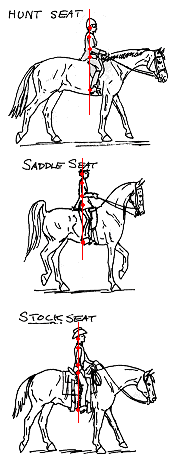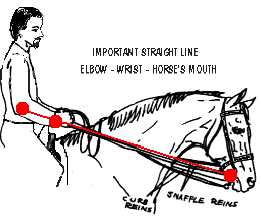The Military Seat
This short article may draw fire from those who have a different view of what
the mid-19th Century Military Seat is. The balance point on a horse has never
changed, nor has the recognition of it, however, some drawings and paintings
lend credence to a stylized version of a secure seat. For this reason I ask all
serious military riders to look to their cavalry manuals and not the paintings.
The long stirrup and leg jutting forward while the buttocks are pressed into
the cantle is not correct. If you want your horse to last on the march you would
never ride in such a position - applying weight to the rear of the saddle by pushing the
leg forward will make your horse sore over the kidneys and soon you will be walking.
It's true that riders of the era rode with long stirrups as compared to that of
riders today but this did not make the rider push his legs forward from the
waist or knee.
The correct military seat is one that interferes the least with the horse's
actions and gives you the most secure seat while working at the different gaits, which
means sitting over the horse's center of motion. The
"forward seat" was developed after the Civil War so we will not discuss this
position, it applies mainly to jumping and riding fast over broken terrain - not
the classic military
riding position.
Imagine if you will, sitting on your horse, when through some trick of magic
the horse disappears and you are left in the air. Will you fall to the ground and
land on your feet? Or will you fall to the ground landing on your chest or
rump? If the answer is on your feet - then you have acquired the correct body
position.

|
Here you can see the classic position at the walk in the many forms of riding
we do. Note the straight line from the ear through the shoulder, elbow, hip and
heel. The stirrup may lengthen or shorten but the basic secure
position is the same. If the horse disappeared from underneath any of these riders
they would surely land on their feet! What
happens when the legs draw back to the flanks? You lose the security of your
seat.
What happens when the legs move forward to the shoulder?
You lose the communication you need. Your horse may feel less secure.
Your horse may also develop a sore back.
How do I tell if I have the correct posture?
You can test yourself on the ground. Take the position as described but stay
on the ground. Learn to give and flex in your joints and feel the position you are
in stabilizing you. Then have a friend push you. Feel how secure you are?
If you fall over, you need to work on this position more. |
Examples of bad habits that need to be worked on by
most riders:
Looking at the horse or looking at the ground - You can't drive your car by
looking at the dashboard so why do you think you can ride your horse this way? You
need to see what your horse sees, otherwise, you are just along
for the ride.
Curling up the back (fetal position) - You lose one of your most important aids, your seat, as
well as putting yourself in a precarious position. (Usually looking at your horse put
you in this position.) It's very easy to fall from this position.
Pushing heels down - This usually is the reason for a leg forward position and
a loss of another important aid, the leg. Practice riding without stirrups
if you can and keep your calf on your horse.
Applying more weight on one stirrup - Your seat is unable to tell your horse
where to go and you may notice a loss of feeling in your foot due to too much weight in
the stirrup. Remember, a stirrup is just a place to rest your feet, not a means to
balance yourself on the top of the horse. If you have ever had your saddle
slip sideways on your horse the cause of it was probably your lack of balance
while riding and not the tightness of the girth. Practice riding without stirrups to
correct this problem.
Train yourself above all else to keep a secure, balanced seat to increase your
safety as well as your horse's comfort. Only through riding regularly can
you improve your horsemanship and your horse's performance.
Here is another straight line that
will give you more control and make your horse a better partner.....
 |
Here is an illustration of the correct line between the horse's mouth and the
riders elbow, including the wrist. This line is the second most important line you
need to know. It gives you direct communication with your horse through the reins. |
View
Poinsett's description and artist's drawing of the military rider position (1841)
Pictures on this page are drawn by Susan Harris from Horsemanship in
Pictures.
Article written by
Linneus
Ahearn



